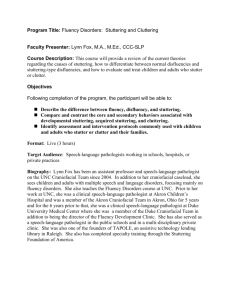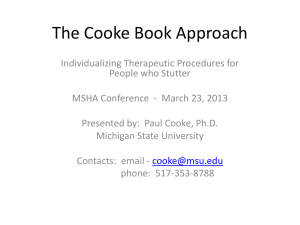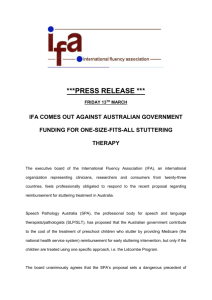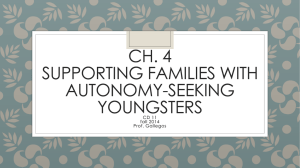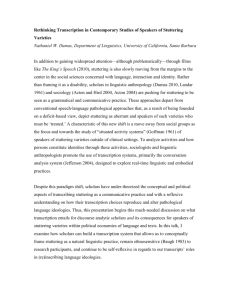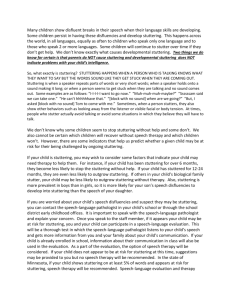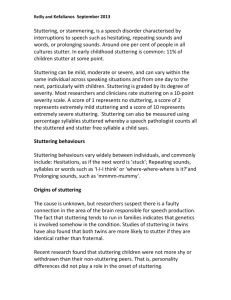Are Self-Help/Mutual Aid Groups Effective in Helping People Who
advertisement
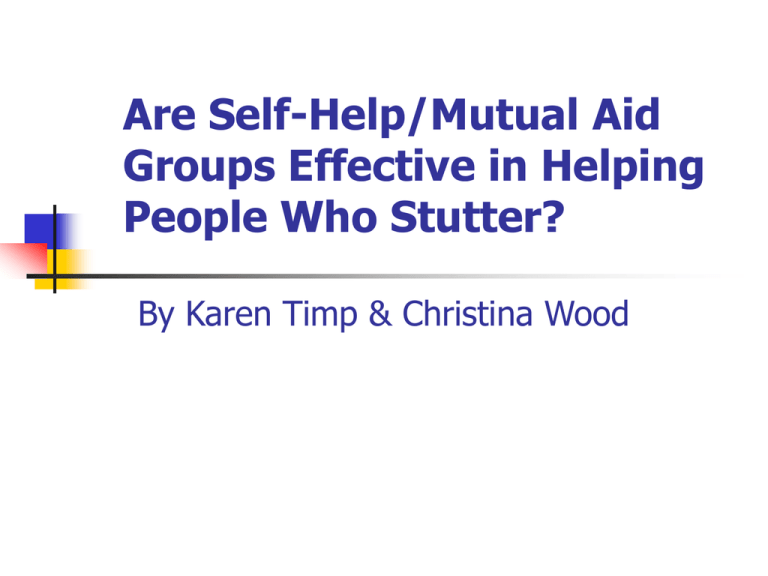
Are Self-Help/Mutual Aid Groups Effective in Helping People Who Stutter? By Karen Timp & Christina Wood Definition: Self-Help/Mutual Aid Groups "Action taken by individuals based on their own internal resources or experiences to help themselves effect personal change . . . Support, encouragement, and the sharing of experiential knowledge from a group to assist in effecting individual or group change” (Reeves, 2007, 5). "Discuss experiential knowledge, are nonjudgmental, and encourage role play" (Irwin, 2007, 15). Definition: Self-Help/Mutual Aid Groups “Voluntary, small group structures for mutual aid and the accomplishment of a special purpose . . . usually formed by peers who have come together for mutual assistance in satisfying a common need, overcoming a common handicap or life-disrupting problem and bringing about desired social and/or personal change” (Yaruss, 2007, 257). History of Self-Help Groups For People Who Stutter 1960’s National Council of Stutterers (NCOS) established 1977 Speak Easy International founded by Bob Gathman 1977 National Stuttering Project begun by Michael Sugarman and Bob Goldman (National Stuttering Association) Current “chat rooms” or “Internet listservs” available Characteristics of Groups Frequency and amount of time for meetings Number of group members Characteristics of individual group members (age, gender, life experiences, occupations, personality) Discussion topics, interests of members Structure and organization of the group Involvement of Speech-Language Pathologist, parent, spouse, or significant other Benefits Develop coping skills Provide a sense of acceptance and belonging Explore beliefs and feelings about stuttering Maintain stuttering techniques and strategies Share personal experiences Gain empathy and understanding Benefits Increase short-term and long-term success of treatment goals Increase in interpersonal skills Enhance awareness of stuttering Increase interest for receiving treatment Benefits Educate self and others Provide accountability Reflect on self-esteem issues in a safe environment Discuss quality of life and how stuttering affects each individual Address future and present issues (i.e. jobs, relationships) Costs Controversial goals: self-acceptance vs. goal to become a fluent speaker Previously developed successful coping strategies Time limitations Lack of awareness of local group Disinterest in group participation Complacence towards change Fear of disclosure Personal biases and opinions Data Survey of 71 National Stuttering Association members felt that group participation had improved their self-image. Adults in Britain’s Association for Stammerers (AFS) reported that participation facilitated not only attitudinal changes, but also their ability to maintain speech fluency gains over time. People who stutter experience a wide range of benefits from participation in self-help groups. Personal Experience ISAD Conference 2007 "Parole d'Espoir" - making gains in fluency through self-help and friendship in Maruitius Jim Caroopen, started a self-help group on Mauritius. He and Yasvin Somoo, wrote an article about the benefits of self-help groups. The authors note increased confidence, selfacceptance, freedom when speaking to others, and an increased feeling of control over their stuttering. Personal Experience “I now understand that being a person who stutters does not make any difference. I now try and do things that I never dared before. In the past, I used to lie to my parents and friends. I did not like to go out and meet others, and always asked people to do things for me, like making phone calls. At present I can travel alone, go shopping and so on. I still can improve as there are situations that suddenly stimulate an inner fear resulting in blocks, stuttering and timidity, but currently I stutter less, have more confidence and can meet and interact with people.” –Yasvin, Age 20 From http://www.mnsu.edu/comdis/isad10/papers/caroopen10.html Our Evaluation of the Technique We would highly recommend this approach to any client seeking to gain personal benefit from interacting with others in a nonstressful, accepting environment. The vast number of benefits, the growing amount of evidence supporting its effectiveness (as judged by participants), and the viability of combining participation in a self-help group with individual therapy make it a worthwhile and helpful approach for stuttering individuals. Recommendations Group therapy combined with individual therapy (or group therapy alone for maintenance) Inclusion of a Speech-Language Pathologist or a professional counselor as mediator or facilitator Inclusion of parents, spouse, or significant other in the group as desired by the client References Caroopen, J. & Somoo, Y. (2007). "Parole d'Espoir" - making gains in fluency through self-help and friendship in Maruitius. International Stuttering Awareness Day Online Conference, 2007. Retrieved December 16, 2007 from www.mnsu.edu/comdis/isad10/papers/caroopen10.html Irwin, M. (2007). SLPs and self-help groups—Why a close relationship is vital. Perspectives on fluency and fluency disorders, 17 (1), 13-15. Lukong, J. (2007). Speech therapy services to be provided to emerging self-help groups for people who stutter in Africa under the framework of the International Speech Project—Stuttering. Perspectives on fluency and fluency disorders, 17 (1), 16-18. References Reeves, L. (2007). Are self-help/mutual aid groups and professional intervention mutually exclusive concepts for helping those affected by stuttering? Perspectives on fluency and fluency disorders, 17 (1), 4-8. Trichon, M. (2007). Getting the maximum benefits from support groups: Perspectives of members and group leaders. Perspectives on fluency and fluency disorders, 17 (1), 10-13. Yaruss, J.S., Quesal, R.W., & Reeves, L. (2007). Self-help and mutual aid groups as an adjunct to stuttering therapy. In Conture, E.G., & Curlee, R.F. (Eds.), Stuttering and related disorders of fluency (3rd ed.) New York: Thieme Medical Publishers, Inc.
